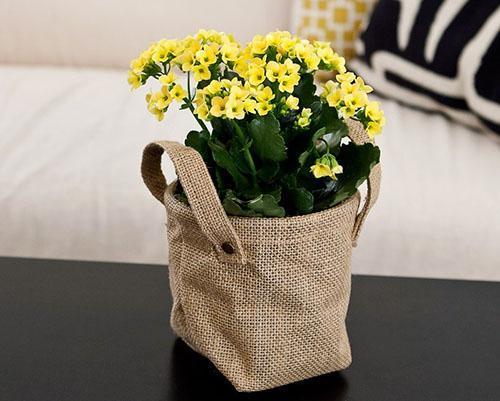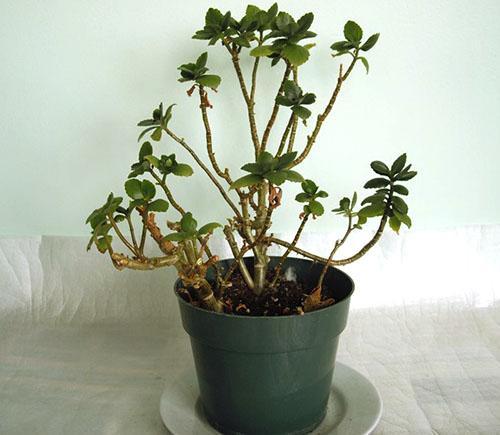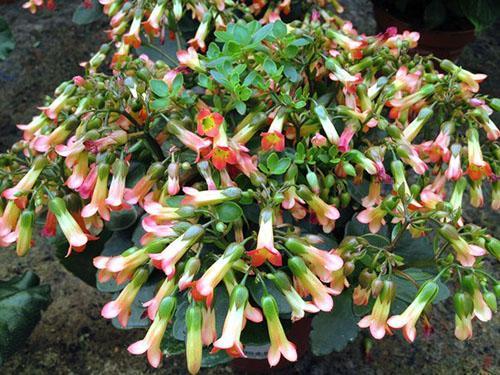Why Kalanchoe does not bloom at home
 The widespread distribution of Kalanchoe as a culture began in the late 80s of the last century, when catchy double hybrids, known today as Kalanchoe Kalandiva, were first obtained. With all the variety of existing Kalanchoe subspecies, these potted plants amazed and continue to amaze with their appearance.
The widespread distribution of Kalanchoe as a culture began in the late 80s of the last century, when catchy double hybrids, known today as Kalanchoe Kalandiva, were first obtained. With all the variety of existing Kalanchoe subspecies, these potted plants amazed and continue to amaze with their appearance.
On a bright green rosette of glossy leaves, it is as if an air cap of white, pink, yellow or red flowers lies. And if we consider that the Kalanchoe does not require special care and is positioned as a long flowering plant, the interest in culture exceeded all expectations.

As a result, in Europe, the Kalanchoe became famous as a "disposable" plant, and in America and the southern regions of the world, flowering varieties of this culture can be seen more often in gardens than on window sills.
Why does Kalanchoe not bloom at home? What care and maintenance conditions are required for a plant so that lush inflorescences appear on it again, and the bush itself remains as compact and attractive?
Why Kalanchoe grows up, but does not bloom?
 And yet you should not throw away a faded bush or grow unattractive thickets on the window in the hope that the plant will come to its senses and give buds. What to do if Kalanchoe does not bloom? There are several reasons why the flowers from the Kalanchoe cannot be waited for:
And yet you should not throw away a faded bush or grow unattractive thickets on the window in the hope that the plant will come to its senses and give buds. What to do if Kalanchoe does not bloom? There are several reasons why the flowers from the Kalanchoe cannot be waited for:
- First of all, this is a lack of information about the plant and the assurance of sellers that no special care for the potted crop is required.
- The plant may lack light, which leads to stretching of the shoots and a lack of strength for the formation of inflorescences.
- Kalanchoe cannot lay flower buds, since it stays in the light for more than 12 hours a day.
Indeed, Kalanchoe is one of the most unassuming plants. But to achieve flowering at home, Kalanchoe care will not be the most common.
 Since you can always see flowering bushes in stores, you get the impression of the eternal flowering of culture. In fact, flower suppliers before sending them to retail chains achieve the appearance of buds by forcing. A fairly small plant with a modest root system is planted in a shipping pot, the soil in which contains nutrients and fertilizers for only a couple of months. Then Kalanchoe from 14 to 42 days, depending on the species and variety, stays in conditions of a short, about 10 hours, daylight hours, which forces the bushes to lay flower buds.
Since you can always see flowering bushes in stores, you get the impression of the eternal flowering of culture. In fact, flower suppliers before sending them to retail chains achieve the appearance of buds by forcing. A fairly small plant with a modest root system is planted in a shipping pot, the soil in which contains nutrients and fertilizers for only a couple of months. Then Kalanchoe from 14 to 42 days, depending on the species and variety, stays in conditions of a short, about 10 hours, daylight hours, which forces the bushes to lay flower buds.
Getting into home conditions, such a plant with moderate watering, good lighting and a suitable temperature, giving all its strength, blooms due to the remains of nutrients in the pot. Therefore, buying a flowering bush and wanting to see its spectacular inflorescences again, you will have to help it accumulate strength, and then make the Kalanchoe bloom again at home.
Kalanchoe care at home after flowering
 When wilted peduncles appear on the Kalanchoe bush, they are removed.And in the spring, after the complete cessation of flowering, the frequency and amount of watering are slightly reduced, since root rot due to increased soil moisture is the most common cause of the death of Kalanchoe at home. When watering, it is better to focus on the slightly dried topsoil, and in the warm season - on the state and elasticity of the leaves.
When wilted peduncles appear on the Kalanchoe bush, they are removed.And in the spring, after the complete cessation of flowering, the frequency and amount of watering are slightly reduced, since root rot due to increased soil moisture is the most common cause of the death of Kalanchoe at home. When watering, it is better to focus on the slightly dried topsoil, and in the warm season - on the state and elasticity of the leaves.
If necessary, the Kalanchoe can be transplanted at the same time. A signal that the plant does not have enough pot volume is an earthen lump completely braided by roots. It should be remembered that the Kalanchoe feels better in ceramic dishes with a diameter of 12 to 18 cm and does not relate too well to the neighborhood with other cultures, except for succulents. If desired, you can plant two or three related Kalanchoe flowers with different shades in one container, which will only increase the decorative effect of the composition, but will not complicate its care.
To get Kalanchoe to start at home, you can organize a short daylight hours for several plants in one pot at once.
For transplanting Kalanchoe, both ready-made soil for succulents and soil for flowering ornamental crops with the addition of a small amount of sand are suitable. If desired, potting soil can be made independently from:
- 2 parts of humus;
- 2 parts of sod land;
- 2 parts of coarse sand;
- 1 part crushed charcoal;
- 1 part crushed brick chips.
To reduce the acidity of the soil, lime flour is added to it. The dormant period, when the Kalanchoe does not bloom and grows upward, restoring strength, lasts from spring to mid-autumn.
How to make Kalanchoe bloom at home?
 After wilting of inflorescences and until the end of August, Kalanchoe requires additional dressings, which are best done twice a month, using ready-made mixtures for succulents.
After wilting of inflorescences and until the end of August, Kalanchoe requires additional dressings, which are best done twice a month, using ready-made mixtures for succulents.
Before starting a set of flower buds, it is important to reduce the amount of nitrogen in the fertilizer in order to limit the growth of shoots and foliage, redirecting forces to the formation of buds.
A month after the completion of flowering, the Kalanchoe is pruned:
- on young bushes that did not have time to grow, pinching the most active growth points;
- on adult plants with lignified shoots, cutting them to the height required to obtain a compact crown.
 This measure will allow not only to prevent the Kalanchoe from stretching, but also to increase the number of shoots before blooming, on the tops of which buds are formed. The natural process of bud formation on the Kalanchoe starts when the length of daylight begins to decrease. In the middle lane, this occurs from October to mid-March.
This measure will allow not only to prevent the Kalanchoe from stretching, but also to increase the number of shoots before blooming, on the tops of which buds are formed. The natural process of bud formation on the Kalanchoe starts when the length of daylight begins to decrease. In the middle lane, this occurs from October to mid-March.
 Moreover, during the dormant period, when the plant gives new shoots, builds up the green mass and lays buds for future flowering, the Kalanchoe will be comfortable at a temperature:
Moreover, during the dormant period, when the plant gives new shoots, builds up the green mass and lays buds for future flowering, the Kalanchoe will be comfortable at a temperature:
- 18–20 ° C at night;
- 22-27 ° C during the day.
If the temperature drops below minimum values at night or the room gets hotter than 24 ° C, there is a delay in bud formation.
Drafts and stay in the cold have an extremely negative effect on the plant. Therefore, you should not put the Kalanchoe, either next to heating devices, or near a window or a balcony door.
Duration and intensity of lighting for Kalanchoe
 One of the most important factors in caring for Kalanchoe at home before flowering is adequate lighting:
One of the most important factors in caring for Kalanchoe at home before flowering is adequate lighting:
- During the dormant period, that is, from March to September in the morning and afternoon hours, the plants are provided with the maximum possible lighting, and at noon, when there is a high risk of burns, the bushes shade.
- In autumn and winter, there is little natural light, so shading is not required, and in case of cloudy weather or the Kalanchoe being on the northern windows, it is better to arrange additional lighting.
 The level of illumination and comfort of the Kalanchoe can be judged by the leaves and shoots of the plant:
The level of illumination and comfort of the Kalanchoe can be judged by the leaves and shoots of the plant:
- With sufficient light, platinum sheets have a rich color, good size and healthy appearance.
- If there is not enough light, the foliage turns pale, and new stems and leaves become thinner and smaller.Old shoots stretch out, Kalanchoe does not bloom even if the duration of daylight is maintained.
- Excess light and heat energy leads to leaf burns that look like dried, whitish spots. And the growth of shoots in excessive light is suspended.
To program the flowering of the Kalanchoe, home care must include limiting daylight hours to 8-10 hours.
If the plants are illuminated for longer, the bud formation process will not start in the autumn-winter time. And here it is necessary to take into account the sources of artificial lighting. Therefore, the easiest way, forcing the Kalanchoe to bloom, at home in the evening and until morning, cover the plants with a dark cloth cap or put the pot in a closet or pantry.
Depending on the Kalanchoe variety, the plant needs from 10 to 24 days to comply with such a light limitation for laying buds. If everything is done correctly, then already at the beginning of winter the plants will delight with opening buds, and flowering will last from 4 to 11 weeks.
Please tell me the kind of Kalanchoe.
You have pinnate Kalanchoe or Kalandiva. Small plants are very similar to each other. The main difference is flowering.
Thank. We will wait when it blooms.
How do you like the color? Everything is fine?
You have a beautiful, healthy plant. If you want to achieve lush flowering, you need to stimulate the plant. Apply fertilizer for budding.
good evening, I planted a scion (took it from a friend. It grows well, but only upwards. I have to cut it off? I don't know what to do ...
To get a lush bush, you need to pinch the top. If the plant is too tall, cut off the stalk. Sprinkle the cut with activated carbon or wood ash.
Good afternoon! Can you please tell me what to do with my Kalonchoe? it has grown so much that it has already occupied half of the windowsill) and does not bloom, there are no large leaves ((((
Prune and stimulate flower buds with a special fertilizer. You can buy fertilizer at any flower shop.
Tell me, if the Kalanchoe is very tall, can I cut it in half? Do this before or after the leaves? By the way, it just bloomed. It can't ruin the flower, can it? I have that Kalanchoe, which is healing
Pruning Kalanchoe will not spoil, but only help to rejuvenate. And you just need to cut after the end of flowering, preferably in spring (and now it is almost spring, so you can already). They are usually cut off immediately after the leaves, a couple of millimeters higher, so that a long stump does not remain. The pruning height is determined depending on the total height of the bush. If the flower is too long, and the old stem is bare at the bottom, you can cut it shorter. But from the cuttings obtained, new plants can be grown.
the flower stretches out leans straight towards the sun and does not bloom, I don’t know what to do, I’m afraid it will break
This is your Kalanchoe so wide. It is just that when the lower leaves grew, he did not have enough light, but for the upper "burdocks" it was more than enough. Moreover, they did not pinch him in time, so he stretched out. Yesterday I just blew my heads off so handsome and put them in separate pots. And what can you do already? You can, of course, put a support, but all the same, the lower leaves will fall off over time and bare stems will stick out, and there is a chance that the lateral buds will wake up.
I don't know what to do with white, it grows up.
Tell me how I can fix the situation, I want her to be the same as her red neighbor
So cut it back if the bush is already very long. Pruning will stimulate the appearance of side branches, and the Kalanchoe will become lush again. And the flower begins to stretch if it lacks lighting. Well, from old age, as I noticed, the lower leaves also fall off and stick out naked sticks. In this case, I just root the young tops, and just throw away the old bush with stumps. So to speak, I am doing rejuvenation.
Tell me what is better to do with this Kalanchoe? does not bloom for the 2nd year. I observe the light / shadow mode all the time. can prune (if yes, then now or in the spring?) or are there other options?
Thank you in advance
Maybe the flower is just hot? In the heat, he does not lay flower buds. It is advisable to prune in the spring, however, Kalanchoe respond well to a haircut even in winter. You can cut it now, and then start feeding it with a mineral complex for flowering.
And this year I bought Kalanchoe, after it faded, I made the formation.
And planted small branches separately.
The kids have bloomed and now I have one flower in place, 10 pieces are blooming.
Tell me what happens to him. .. does not bloom
Mine was terrible, dried up in several pots, but bloomed! Well, I decided to combine them. Now they have any kind of circumcision ... my tree has grown straight